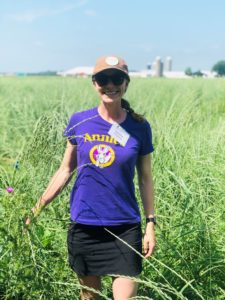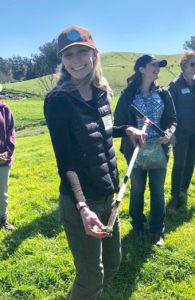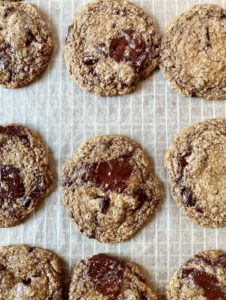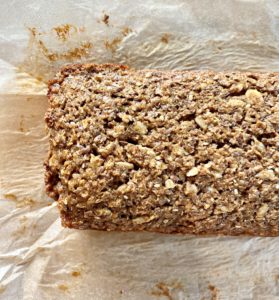Interview with Christina Skonberg
This interview is part of a series that highlights the work of various individuals and organizations within the Kernza® network. Through these interviews, we aim to share and celebrate that there is a large and ever-changing ecosystem that moves Kernza® perennial grain forward. If you would like your organization’s work to be featured in an interview, please email Sophia Skelly. To learn more about the Kernza® network, visit our directory.

Can you give a brief overview of your work and how it intersects with Kernza® and perennial agriculture?
I lead sustainability for our natural and organic division at General Mills, which includes the brands Annie’s, Cascadian Farm, and Muir Glen. My work on these brands focuses on building resilience at the foundation of our supply chain—in agriculture. Agriculture accounts for more than half of General Mills’ entire greenhouse gas footprint, so farming and ranching represents our biggest opportunity to address climate change and improve environmental outcomes in areas like biodiversity and water quality. In addition to managing some of our regenerative agriculture grower engagement programs, I work with our brand teams to translate agricultural impact into credible and digestible messaging that resonates with our consumers.
I first heard about Kernza® when I was in grad school, studying agricultural science. I was researching perennial crop breeding efforts and learning about Wes Jackson and his vision of perennial agriculture. Up until that point, I had learned primarily about crop breeding efforts that focused narrowly on traditional metrics of agricultural success: yield, shelf stability and disease resistance. All of those are, of course, really important traits. But Kernza® breeding efforts introduced me to a much more holistic way of thinking about advancements in agriculture, and what really stood out was this idea that Kernza® could expand how we define success in the food system. Kernza®—with its deep roots that can help prevent soil erosion, store carbon in the soil, and reduce water pollution by preventing nitrate leaching—represents an opportunity to address so many of the negative externalities generated by our modern food system.
At General Mills, Kernza® has pushed us to think about time horizons beyond the quarterly reporting cycle. We understand that breeding a new crop and making it agronomically viable takes many years. This isn’t a crop that’s going to yield immediate results for our business in the short term. Rather, we see our investment in the commercialization of Kernza® as a journey that will pay dividends down the road, in the form of resilient ecosystems. Because our business relies on the stable availability of ingredients, investing in the natural resources and the communities who grow those ingredients is foundational to our success.
I often think about Wes Jackson’s saying, “If your life’s work can be accomplished in your lifetime, you’re not thinking big enough.” We’re trying to think beyond our lifetimes to consider how the next generations will produce food against this backdrop of a fragile climate.
What are some challenges involved with communicating issues related to agriculture to the average consumer, or even within your company?
One of the most important ways we share our brand actions with consumers is through the real estate on our packaging. We’re faced with the challenge of balancing snappy, attention-grabbing messaging with scientific credibility. It’s a good thing I’m not in marketing, otherwise our boxes would just be lists of disclaimers and footnotes referring back to peer reviewed literature.
I think it’s a matter of finding the balance between rigorous substantiation and consumer resonance. And the team at the Land Institute has been such a great resource in helping us navigate that.
What is one of the best parts of your job? What gets you out of bed in the morning?

Partnering with and learning from farmers is one of the most energizing parts of my job. The producers I’ve met through my work are some of the most thoughtful environmentalists I’ve ever encountered. Perhaps even more energizing than working with producers is the opportunity to connect them to our consumers. Many of the folks who grow ingredients for our products don’t have visibility to their end consumers. They work tirelessly to cultivate food and often don’t get to see who benefits from the fruits of their labor. Several of our projects at General Mills aim to close that gap and elevate the producers at the foundation of our supply chain. Last year, one of our Montana spelt farmers who was featured on the back of an Annie’s mac and cheese box received a letter in the mail from a little girl in Seattle, thanking him for growing the spelt in her mac and cheese. The letter meant so much to the farmer and his family, and it helped demonstrate that by celebrating farmers through our packaging and other communications channels, we can create important connection points between eaters and producers.

Do you have a favorite Kernza® food or drink that you’ve been able to try?
So many! I’ll start with the most indulgent: Kernza® chocolate chunk cookies with brown butter. The Kernza® behaves a bit like oats in an oatmeal cookie and gives it this lovely chewy texture and coconut-like flavor.
I’ve also been baking a seedy Kernza® yogurt bread. It’s essentially just Kernza®, yogurt, honey, and a smattering of different seeds. It’s terrific with salty butter and a tart jam—like plum or rhubarb.
Oh my gosh, that sounds so good.
It’s very yummy. Another Kernza® go-to in my kitchen is a warm, whole grain Kernza® salad with honey, butternut squash, feta, pistachios, a little bit of vinegar, and plenty of salt. I love the texture of the whole grains.

Kernza® would be so good with squash. I hadn’t thought about that combination.
It’s delicious. I actually got my inspiration for the squash dish from a Kernza® party at the Expo West trade show in 2018. Cascadian Farm, the Feed Feed, and the Land Institute hosted an event with lots of different Kernza® culinary creations. I will not soon forget that event!
Looking into the future, do you have any other plans or aspirations related to Kernza®, or perennial agriculture more broadly?
Professionally, I’m hopeful that we can bring a Kernza® cereal product to market and build a consumer-facing narrative around the benefits of perennial agriculture.
Personally, I’m looking forward to framing a Kernza® plant specimen that I collected and preserved in a botanical press. It’s from a field visit in Wisconsin during the 2019 International Kernza® Conference. I’m planning to hang it on my wall as a hopeful reminder of what’s possible in our agriculture system.